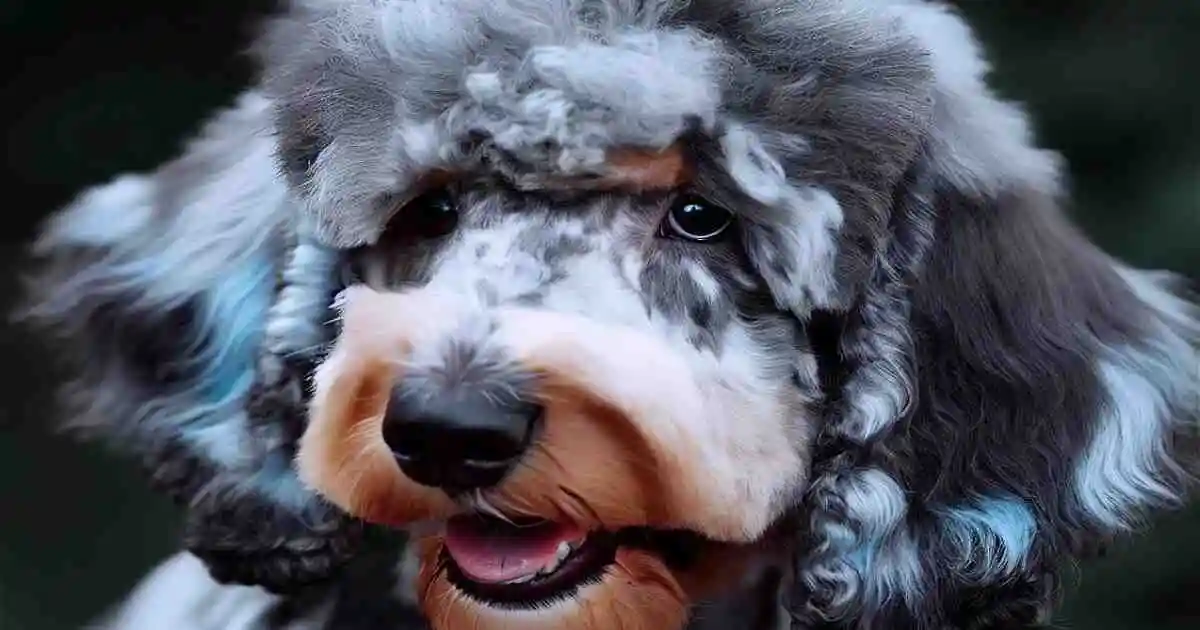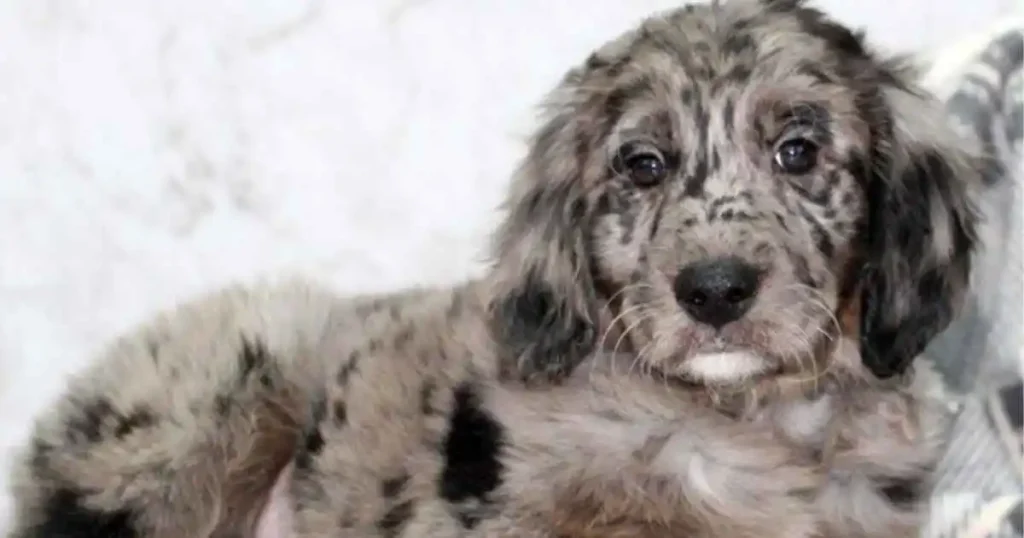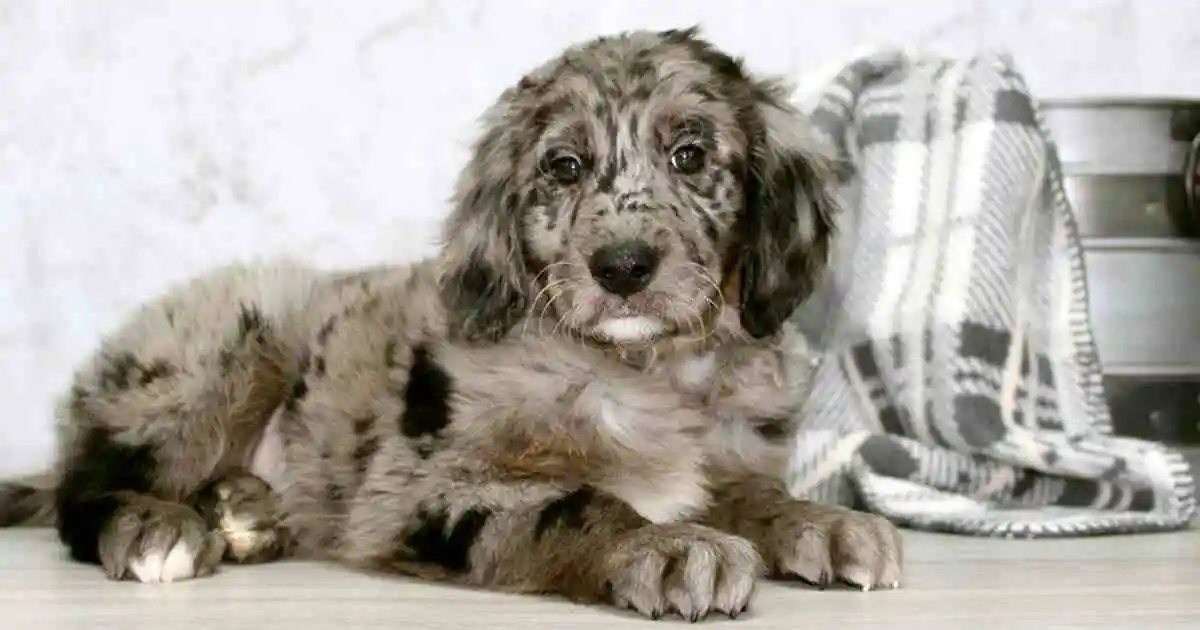The allure of the Blue Merle Goldendoodle captivates many, standing out as a unique and visually stunning variation within the Goldendoodle breed. Thanks to their fascinating blue-gray coat adorned with black patches or spots and potential for captivating blue or green eyes, these dogs are not just pets but walking masterpieces.
Originating from the careful crossing of a Golden Retriever and a Merle Poodle, the Blue Merle Goldendoodle not only boasts an attractive appearance but also brings joy with its friendly and intelligent personality. Their hypoallergenic coats, a trait inherited from their Poodle lineage, make them a favored choice for families, particularly those with allergies.
This comprehensive guide delves into the rarity and origin of the Blue Merle Goldendoodle, exploring its history, distinctive color variations such as silver merle, red merle, and the fascinating merle gene responsible for their unique coat patterns.
Additionally, readers will gain insight into their temperament, potential health concerns including hip dysplasia and progressive retinal atrophy, and the importance of regular grooming to maintain their striking fleece coats. Whether curious about the various Goldendoodle sizes or considering the addition of a Blue Merle Goldendoodle puppy to the family, this guide offers valuable information for prospective and current owners alike.
Table of Contents
ToggleThe Rarity and Origin of Blue Merle Goldendoodles
The Blue Merle Goldendoodle, a striking hybrid breed, owes its unique coat patterns and colors to the merle gene, predominantly found in certain dog breeds like Great Danes and Australian Cattle dogs. This gene, responsible for the marbled or speckled appearance, is a dominant trait that can create a stunning array of colors in the Goldendoodle’s coat.
Interestingly, the origin of the merle gene in Poodles, one half of the Blue Merle Goldendoodle’s lineage, remains a topic of debate among geneticists and breeders. Some suggest it has always been part of the Poodle gene pool, while others believe it was introduced through outcrossing with other breeds.
Understanding the Merle Gene
Mutation and Origin: The merle pattern in dogs results from a mutation in the PMEL gene, which affects pigment production. This mutation likely first occurred in Europe several hundred years ago, primarily in herding dogs or hounds.
Gene Mechanics: The specific mutation involves the attachment of a piece of virus RNA to a particular spot on the dog’s DNA, influencing the pigment gene. The length of the merle allele varies, which in turn affects the coat pattern’s appearance, ranging from large blotches to a more mottled look.
Rarity and Breeding Challenges
Genetic Pool Limitations: Blue Merle Goldendoodles are less common than other Goldendoodle varieties, primarily due to the smaller genetic pool of Merle Poodles available for breeding.
Breeding Specifics: The merle gene is absent in Golden Retrievers, making the presence of the gene in Goldendoodles solely dependent on the Poodle parent. This selective breeding necessity contributes to the rarity of the Blue Merle variety.
Desirability and Cost: The unique and eye-catching appearance of Blue Merle Goldendoodles makes them highly sought after, often fetching a higher price in the pet market.
Health Considerations
The breeding of merle dogs, including Blue Merle Goldendoodles, must be approached with caution due to potential health risks associated with the merle gene, such as hearing and vision problems. Responsible breeding practices are crucial to minimize these risks and ensure the health of the puppies.

In summary, the Blue Merle Goldendoodle not only captivates with its beauty but also embodies a complex tapestry of genetics and breeding intricacies. Their rarity, combined with the specific requirements for their breeding, makes them both a marvel and a challenge within the canine world.
History of Blue Merle Goldendoodle
Blue Merle Goldendoodles, a striking and relatively recent addition to the world of designer dogs, trace their lineage back to a cross between a Merle Poodle and a Golden Retriever. This hybrid breed combines the intelligent and friendly traits of the Golden Retriever with the distinctive, patterned coat of the Merle Poodle.
Emergence of the Breed
The concept of the Goldendoodle itself originated in the 1990s, with the Blue Merle variety appearing shortly thereafter. These dogs were bred to achieve a balance of the hypoallergenic qualities of Poodles and the amiable nature of Golden Retrievers, with the added unique aesthetic of the merle coat pattern.
Genetic Contributions
The merle gene, which is responsible for the random patterns of darker spots against a lighter base in the coat, comes exclusively from the Poodle side. Golden Retrievers do not carry the merle gene, so the presence of Blue Merle in Goldendoodles is solely dependent on the Poodle parent.
Recognition and Popularity
Despite their popularity among dog enthusiasts and families, Merle Goldendoodles, including the Blue Merle variety, are not recognized as a distinct breed by the American Kennel Club (AKC). This lack of official recognition does not diminish their appeal but does influence breeding practices and the regulation of breed standards.
Anecdotal Origins
It is believed that the first Goldendoodle may have been bred by Monica Dickens, the great-granddaughter of famed author Charles Dickens, in 1969. Although the initial breeding aimed to create an intelligent and friendly family pet, the specific introduction of the merle pattern likely occurred decades later as breeders sought to diversify the physical characteristics of Goldendoodles.
This blend of historical and genetic factors contributes to the unique position of Blue Merle Goldendoodles in the pet market today, combining aesthetic appeal with the desirable traits of their parent breeds.
Varieties of the Merle Goldendoodle’s Popular Coat Colors
The Merle Goldendoodle, known for its distinctive and attractive coat patterns, offers a variety of color variations that appeal to a wide range of dog lovers. These variations not only enhance the breed’s aesthetic appeal but also contribute to its popularity. Here, we explore the most sought-after color variations of the Merle Goldendoodle.
A Colorful Canine Marvel
The Blue Merle Mini Goldendoodle is a captivating hybrid breed that brings together the cherished traits of the Miniature Poodle and Golden Retriever with the striking blue merle coat pattern. While Red Mini Goldendoodles, Black Mini Goldendoodles, and Black and White Mini Goldendoodles each offer their own unique charm, the Blue Merle variation stands out with its mesmerizing blend of gray, black, and white patches.
Whether you’re drawn to the fiery hues of the Red Mini Goldendoodle, the classic elegance of the Black Mini Goldendoodle, or the bold contrast of the Black and White Mini Goldendoodle, the Blue Merle Mini Goldendoodle adds an extraordinary burst of color to any family. These dogs not only boast stunning aesthetics but also inherit the intelligence, friendliness, and hypoallergenic qualities characteristic of their parent breeds. With their charming personalities and extraordinary coloring, Blue Merle Mini Goldendoodles make for cherished companions in any household.
Blue Merle Goldendoodle
The Blue Merle Goldendoodle is perhaps the most iconic of the merle variations. This coloration features a primarily blue-gray coat peppered with black patches. The intriguing eye color can range from blue to green, adding to their mystical appearance. The blue merle’s striking looks are complemented by a black nose, which stands out against the lighter coat.
Chocolate Merle Goldendoodle
Chocolate Merle Goldendoodles boast a rich, deep brown base color with darker brown or black marbling that creates a dramatic and beautiful effect. This variation often captivates those who prefer a warmer toned dog. The chocolate merle can also display varying shades of brown within their marbled patterns, giving each dog a unique coat.
Sable Merle Goldendoodle
Sable Merle Goldendoodles feature a mix of colors, typically with a darker, sable base interspersed with lighter patches or streaks. This variation is known for changing shades as the dog matures, often becoming more pronounced and beautiful with age.
Phantom, Parti, and Tri-Colored Merle Goldendoodles
These Goldendoodles display a fascinating array of two or more colors, which include:
Phantom Merle: Characterized by distinct markings over the eyes, on the sides of the snout, and beneath the tail.
Parti Merle: These dogs have a coat that is at least 50% white, with patches of any other color, offering a stark and appealing contrast.
Tri-Colored Merle: Incorporating three distinct colors, this variation is one of the most visually complex and appealing.
Additional Unique Patterns
Merle Goldendoodles can also exhibit a range of other unique coat patterns:
Abstract Goldendoodles: Typically showcase a solid primary color with strategic splashes of white across their chest, legs, and face.
Tuxedo Goldendoodles: Known for their solid white chest and underbelly, which often extends from their chin down their legs, giving the appearance of wearing a tuxedo.
Swirl Pattern Coat: This lesser-seen pattern features a lighter base coat with swirls of darker colors, adding a whimsical and unique touch to their appearance.
These color variations not only make the Merle Goldendoodle visually appealing but also add to the uniqueness of each individual dog, making them highly sought after by enthusiasts and potential dog owners.
Physical Characteristics and Appearance
Merle Goldendoodles are celebrated not only for their unique color patterns but also for their robust and adaptable physical structure. These dogs possess a muscular build that supports a variety of activities, making them excellent companions for families and individuals alike.
Build and Size Variations
Merle Goldendoodles come in different sizes which largely depend on the size of the Poodle parent. These include:
Standard Merle Goldendoodles: Typically standing 21 to 24 inches tall and weighing between 50 to 90 pounds, these are the largest of the breed.
Medium Merle Goldendoodles: These dogs stand about 17 to 20 inches tall and weigh between 30 to 50 pounds.
Miniature Merle Goldendoodles: The smallest, standing 14 to 17 inches tall with a weight ranging from 15 to 30 pounds.
Coat Types and Maintenance
The coat of a Merle Goldendoodle can vary significantly, influenced by the traits inherited from the Poodle and Golden Retriever parents. The three main types of coats include:
- Curly: Similar to the Poodle, requiring regular grooming to prevent matting.
- Wavy: This coat type is less prone to matting and combines traits from both parent breeds.
- Straight: The least common, resembling more of the Golden Retriever’s coat, and may require less grooming than the curly or wavy types.
Regular grooming is essential for all types, particularly to manage shedding and maintain coat health.
Facial Features and Expressive Eyes
Merle Goldendoodles often inherit the friendly and approachable facial expressions of the Golden Retriever, combined with the intelligent gaze of the Poodle. Their eyes are particularly expressive, typically showcasing shades of blue or green, which stand out against their unique coat colors. The muzzle is broader than a Poodle’s, and their ears hang close to the head, often with a feathered appearance.
Unique Coat Colors and Patterns
The distinctiveness of the Merle Goldendoodle comes from its coat color and pattern, primarily influenced by the merle gene. Common patterns include:
- Blue Merle: A cool blue or gray base with darker patches.
- Chocolate Merle: Rich brown tones with darker marbling.
- Sable and Parti Variations: These can include mixes of colors with a base of white or a darker shade.
Each puppy can display a unique pattern, which sometimes changes as the dog matures, particularly in lighter-colored coats.
Genetic Considerations
Breeders must consider the genetic aspects seriously, especially concerning the merle gene, to avoid health issues related to coat and eye color inheritance. Responsible breeding practices are crucial to ensure that these dogs not only look spectacular but are also healthy and well-adjusted pets.
Merle Goldendoodles are an excellent example of how thoughtful breeding and genetics can create a visually stunning, loving, and intelligent canine companion. Their physical characteristics not only make them a joy to watch but also a delight to interact with, given their friendly and sociable nature.
Temperament and Personality
Blue Merle Goldendoodles are renowned for their affable and sociable nature, making them ideal companions for families. Their temperament, a blend of the best traits from both the Golden Retriever and the Poodle, ensures they are not only friendly but also highly intelligent and affectionate. Here we explore the key aspects of their personality that make them such beloved pets.
Friendly and Sociable Nature
Family-Oriented Companions: Known for their love of human interaction, Blue Merle Goldendoodles thrive in family environments. They are particularly good with children, displaying a gentle demeanor that makes them safe companions for the youngest family members.
Social Interaction: These dogs enjoy being part of daily activities and are happiest when involved with their human counterparts. Their sociable nature makes them excellent candidates for visits to public places or gatherings.
Intelligence and Trainability
Eager to Please: Blue Merle Goldendoodles are known for their desire to please their owners, which makes them highly trainable. They respond well to positive reinforcement techniques such as praises and treats.
Training Requirements: Consistent training is crucial from a young age to ensure that these dogs understand boundaries and behave appropriately. Their intelligence means they pick up commands quickly, but they also benefit from mental stimulation to prevent boredom.
Affectionate and Loving
Bonding with Family Members: These dogs form strong bonds with their family members and often become particularly attached to one person in the household. However, they share their affection freely with all family members.
Expressing Affection: Blue Merle Goldendoodles are not shy about showing their love, often using nuzzles, snuggles, and gentle pawing to express their feelings.
Adaptability to Various Living Situations
Versatility in Living Environments: Whether in a large house with a backyard or a smaller apartment, Blue Merle Goldendoodles can adapt to different living situations as long as they have sufficient exercise.
Interaction with Other Pets: They generally get along well with other pets, including dogs and cats, making them a great addition to homes with existing animals.
Understanding the temperament and personality of Blue Merle Goldendoodles is essential for prospective owners. Their friendly and affectionate nature, combined with their intelligence and adaptability, makes them suitable for a variety of homes and lifestyles.
Health Concerns and Lifespan
The merle gene, responsible for the distinctive coat patterns of Blue Merle Goldendoodles, also brings potential health risks, particularly when two merle genes are present (double merle). Double merle Goldendoodles may suffer from various health issues, including:
Sensory Impairments: A significant risk of blindness and deafness. Studies indicate that about 25% of double merles suffer from deafness, with a smaller percentage also affected by blindness.
Organ and Skeletal Issues: There is a potential for more severe conditions such as heart and skeletal abnormalities, and even organ failures.
Common Health Concerns in Merle Goldendoodles
Merle Goldendoodles, like all breeds, are susceptible to health issues common to their parent breeds—Golden Retrievers and Poodles. These include:
Hip Dysplasia: A prevalent condition where the hip joint does not fit the socket properly, potentially leading to arthritis or lameness.
Ear Infections: Due to their floppy ears, they are prone to ear infections, which require regular cleaning to prevent.
Eye Problems: Conditions like Progressive Retinal Atrophy (PRA) and cataracts can impair vision.
Thyroid and Neurological Issues: Thyroid malfunctions and various neurological disorders can affect their overall health.
Cancer and Immune Disorders: They may also be at risk for various types of cancers and immune system problems.
Regular veterinary checkups are crucial to diagnose and manage these conditions early.
Lifespan and Care
The lifespan of a Merle Goldendoodle typically ranges from 10 to 15 years. Factors influencing their longevity include genetics, diet, exercise, and comprehensive healthcare. To support a healthy life:
Regular Exercise: Adequate daily exercise helps maintain a healthy weight and supports joint health.
Balanced Diet: A nutritious diet tailored to their age, size, and activity level promotes overall health.
Preventative Health Measures: Regular vaccinations, parasite control, and dental care are essential.
By understanding the specific health risks and general care requirements of Blue Merle Goldendoodles, owners can better prepare to provide a safe, healthy environment for their pets. Regular vet visits and attentive care can mitigate many health issues, ensuring these beautiful dogs live full, vibrant lives.
Grooming and Maintenance

Essential Grooming Tools and Techniques
To maintain the health and appearance of a Blue Merle Goldendoodle’s coat, a set of specific grooming tools and techniques are essential. Here is a breakdown of the necessary tools and their uses:
Slicker Brush: Ideal for detangling and smoothing the coat, ensuring it remains free of mats.
Comb: Helps to fine-tune the grooming process by catching any tangles the slicker brush might miss.
Scissors/Grooming Clippers: Essential for trimming and maintaining the coat’s length and shape.
Dog-safe Shampoo and Conditioner: Specially formulated products help maintain the coat’s health without stripping natural oils.
Nail Clippers/Grinder: Regular nail trims prevent discomfort and mobility issues.
Ear Cleaning Solution and Cotton Balls: Used for regular ear checks to prevent infections.
Regular Grooming Schedule
Maintaining a regular grooming schedule is crucial for the health of your Blue Merle Goldendoodle’s coat and overall well-being. Here’s a recommended routine:
Brushing: Daily brushing is necessary for curly-coated Goldendoodles to prevent matting. For wavy or straight coats, brushing every two days is sufficient.
Bathing: Bathe your Goldendoodle once a month or as needed. It’s important to brush the coat immediately after towel drying and again once completely dry to prevent matting.
Haircuts: Schedule haircuts every 6-12 weeks, depending on the growth rate of your dog’s coat.
Nail Trimming and Ear Cleaning: Regular nail trims and ear checks should be part of the grooming routine to avoid overgrowth and infections.
Grooming Tips for Different Coat Types
The grooming needs of a Blue Merle Goldendoodle can vary based on the type of coat they inherit:
Curly Coated: Requires the most maintenance with daily brushing and regular use of dematting tools.
Wavy Coated: Needs brushing several times a week to prevent tangles and mats.
Straight Coated: While less prone to matting, regular grooming is still necessary to keep the coat clean and tidy.
Professional Grooming and Home Care
While regular home grooming is essential, professional groomers can provide deep cleaning, thorough mat removal, and expert styling that might be challenging to achieve at home. It’s advisable to introduce your Goldendoodle to professional grooming early, ideally before they turn 14 weeks old, to ensure they become comfortable with the process.
For those opting to groom at home, be prepared to invest time in learning the proper techniques and maintaining a consistent schedule to keep your dog looking and feeling their best.
Dietary Considerations for Coat Health
A balanced, nutritious diet plays a significant role in the health of your Goldendoodle’s coat. High-quality dog food that meets their nutritional needs based on age, weight, and activity level is recommended. Regular vet check-ups can also help in identifying any dietary adjustments needed to address or prevent skin and coat issues.
By adhering to these grooming practices, Blue Merle Goldendoodle owners can ensure their pets not only look great but also live a healthy and comfortable life.
Conclusion
The journey through the enchanting world of Blue Merle Goldendoodles has unveiled not only their stunning beauty but also the rich tapestry of genetics, care, and companionship they bring into our lives. Their rare and mesmerizing coat patterns, combined with an affable temperament and keen intelligence, underscore the unique allure of this designer breed.
It’s clear that these dogs are more than just pets; they are loyal companions, ready to bring joy, love, and vibrant energy to their families. The exploration of their origins, health considerations, and grooming needs highlights the importance of responsible ownership and the special role these captivating canines play in the lives of those who choose the dog to welcome them into their homes.
Reflecting on the broader implications, the Blue Merle Goldendoodle’s journey from a curious blend of genetic heritage to a beloved family member speaks volumes about the evolving relationship between humans and the canine world.
This guide serves not only as an introduction to the breed but also as an affirmation of the profound bonds that can form when care, research, and passion for animals come together. As the narrative of the Blue Merle Goldendoodle continues to unfold, their presence is a testament to the beauty and diversity of crossbred dogs, enriching our lives and homes with their unparalleled charm and spirited companionship.
FAQs
Blue merle Goldendoodles are somewhat rare, especially when compared to other Goldendoodle colors. The rarity arises because the merle gene, which is dominant, does not naturally occur in Golden Retrievers—one of the parent breeds of Goldendoodles along with Poodles.
A Merle Goldendoodle has a unique coat pattern characterized by a base color (either black or brown) that is diluted, with random darker patches created by a gene modifier. This pattern often includes blue or chocolate merle, and typically features white markings on the face, chest, feet, and tail.
Merle coloring is specific to certain dog breeds and not a universal trait that can occur in any dog. Notable breeds with merle patterns include the Australian Shepherd, Catahoula Leopard Dog, Miniature American Shepherd, Koolie, Shetland Sheepdog, various collie breeds, Cardigan Welsh Corgi, Pyrenean Shepherd, and the Bergamasco, among others.
A Goldendoodle is a hybrid breed that results from crossing a Golden Retriever with a Poodle. This mix is highly popular due to their attractive appearance, intelligence, hypoallergenic coats, and their effectiveness as therapy pets



